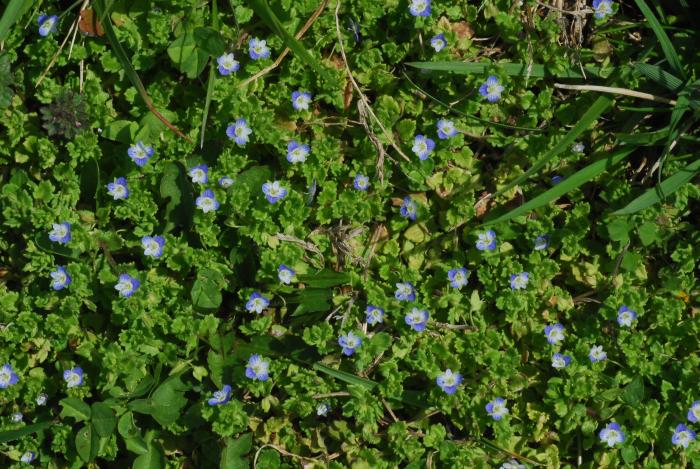Veronica polita Fr.
Wayside Speedwell

Introduced
CC = *
CW = 5
MOC = 45
© SRTurner
Veronica polita Fr.Wayside Speedwell | |
 |
Introduced CC = * CW = 5 MOC = 45 |
© SRTurner |
|
Family - Plantaginaceae Habit - Annual forb from fibrous roots or a slender taproot. Stems - To 30 cm, sprawling and mat-forming, with flowering branches loosely ascending, pubescent with curled nonglandular hairs.
Leaves - Opposite, short-petiolate to nearly sessile, to 1 cm, broadly ovate to orbicular, rounded at tip, rounded to weakly cordate at base, coarsely scalloped or toothed, surfaces pubescent with nonglandular hairs.
Inflorescence - Terminal, open racemes, elongate and sometimes nearly entire length of stem. Bracts alternate, similar to leaves, slightly reduced toward axis tip. Flower peduncles relatively long, to 1 cm, further elongating in fruit.
Flowers - Calyces 3-6 mm long, deeply 4-lobed, the lobes subequal, pubescent with short, curved, nonglandular hairs. Corollas 4-8 mm wide, blue with darker veins, the lower lobe occasionally paler, the throat white, often light greenish at the center. Stamens 2. Style 1, 0.8-1.5 mm long at fruiting.
Fruit - 2.5-4.0 mm long, noticeably wider than long, broadly heart-shaped in profile, flattened, the notch relatively broad and deep (0.8-1.3 mm), the surfaces moderately to densely pubescent with a mixture of longer, glandular and shorter, nonglandular hairs. Seeds mostly 6-12 per locule, 1.3-1.7 mm long, cup-shaped, the convex surface appearing cross-wrinkled, tan to yellowish brown.
Flowering - March - June. Habitat - Disturbed areas including lawns and roadsides. Origin - Native to Eurasia. Lookalikes - Other species of Veronica. Other info. - Steyermark's 1963 Flora of Missouri listed this plant in only five counties. Since then it has spread like wildfire, and is now perhaps the dominant Veronica to be found in the state, at least in the eastern region. It can be recognized by its scalloped, broadly ovate leaves and relatively long flower stalks. The corollas are typically pale to white toward their centers. The small, heart-shaped fruits are a diagnostic feature of this genus. Photographs taken near Labadie, Franklin County, MO, 3-20-2015, 3-25-2015, and 3-20-2020, and along the Katy Trail near Marthasville, Warren County, MO, 3-25-2020 (SRTurner). |